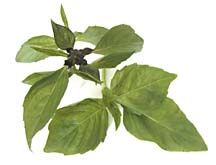
Eleanor Nakama-Mitsunaga

|
Two kinds of fresh basil are most often available in the markets these days -- vibrant green Italian (or Mediterranean) basil and purple-tinged Thai basil. Each has a unique flavor and they shouldn't be used interchangeably.The basics: Basil is an herb in the mint family believed to have originated in India or Southeast Asia. Many varieties are available, from sweet to peppery hot, from lemony to licorice flavor.
The leaves are the prime part of the plant, although the purple flowers of Thai basil are also highly valued. But during harvesting the leaves are never just taken by themselves. They are always picked with stems attached, which promotes new leaf growth and also prolongs the herb's shelf life.
Italian basil, also known as sweet basil, is a staple in Mediterranean cuisine, often used in combination with tomatoes and garlic for sauces or in that signature Italian dish, pesto.
Thai basil is a type of sweet basil called bai horapa. It has a rather pungent anise quality favored in many Southeast Asian dishes.
Basil has also long been valued for medicinal purposes in aiding stomach distress, curbing flatulence and nausea.
Selecting: Fresh basil is sold in plastic containers or by the bunch. Avoid leaves that have brown spots or look withered.
Storing: Fresh basil should be used quickly. It can be stored in the refrigerator for a couple of days. Place the stem in water for longer storage.
Use: Pull leaves off of the stems. They can be used whole, roughly chopped, sliced thinly or pounded in a mortar.
Fresh basil is generally added in the final stages of cooking as prolonged heat tends to break down the flavors. Add basil when sauces are nearly done or quickly stir-fry or pan-fry with other ingredients.
Thai basil is popular in soups, salads or as a wrap -- along with lettuce leaves -- for spring rolls.
Italian pesto makes use of basil in the classic sense, but try an Asian pesto with mint and cilantro leaves, peanut oil, peanuts, garlic, ginger, chile pepper, salt, sugar and lemon juice. This sauce can be used over noodles much like Italian pesto.
Where to buy: Both varieties of fresh basil are available year-round in most markets, with Thai basil also available at farmers markets, Asian markets and in Chinatown. Prices range from $1 a bunch to $1.99 per ounce.
The most common types of basil are the purple-tinged Thai, top, and the broad-leaved Italian varieties.Eleanor Nakama-Mitsunaga is BACK TO TOP
a free-lance food writer. Contact her
online through features@starbulletin.com

